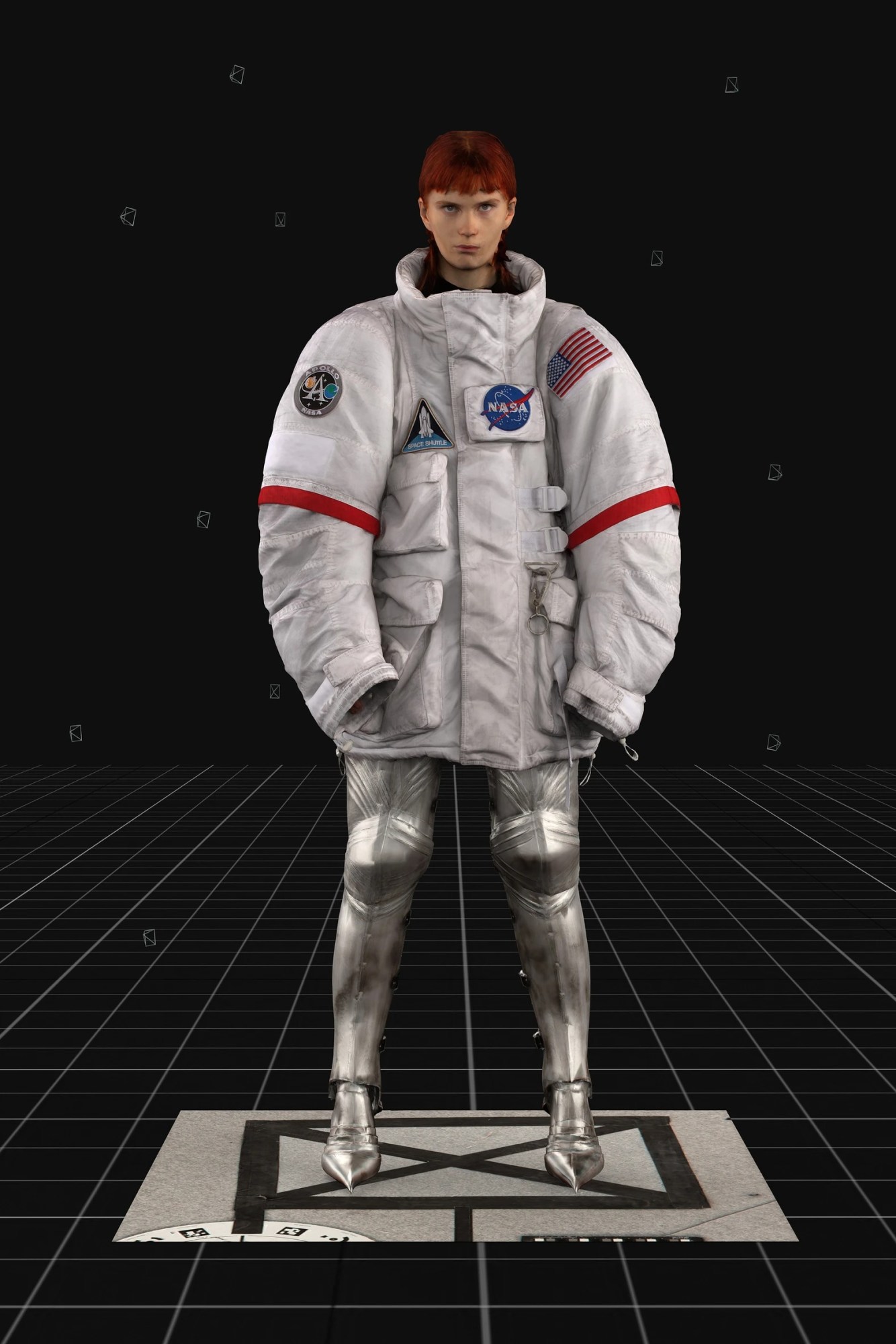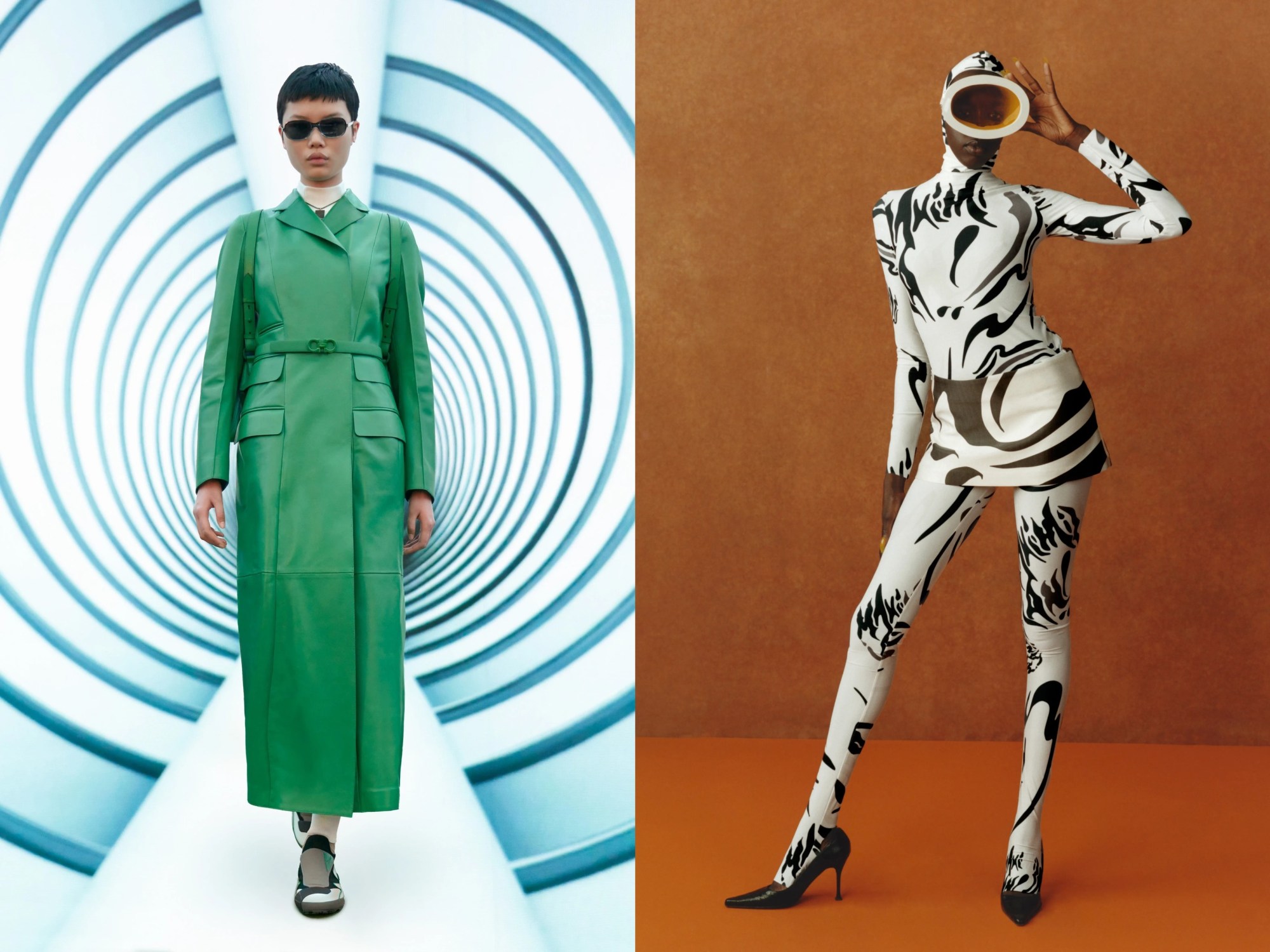Swooping minis, silver boots, astronautical headgear… whether at Maximilian or Balenciaga, AV Vattev or Salvatore Ferragamo, AW21 will be remembered as the season designers looked back to the future, drawing on style tropes of the early Space Age to conjure a spirit of romantic retrofuturism. Looking back on times past is hardly groundbreaking in fashion, but there was something here that went beyond misty-eyed nostalgia. At a time when doom-mongers would have you believe that there’s no end to the pandemic in sight, this felt like a counterpoint to all the pessimism; a reminder of the power of idealism, of times when people felt more hopeful about what the future could be.
Coined in the 80s, but rooted in ideas that date back to early science fiction texts by Jules Verne and H.G. Wells, the term ‘retrofuturism’ refers to the idea of looking back to depictions of the future in earlier eras. In a fashion historical context, an especially salient point of reference is the mid-60s when designers like Pierre Cardin, Andre Courrèges and Paco Rabanne pioneered a new graphic silhouette that riffed the aesthetics of the space race, their work now reading as dispatches from a time when imagination was limitless.
“The dresses I prefer are those I invent for a life that does not yet exist,” said Cardin in the late 60s. Think silver minidresses, goggle glasses and helmets, PVC thigh-high boots and jumpsuits with asymmetrical zippers. So far so spacey. This stylish astronaut look was a nod to series like Star Trek and reflected the romantic view of outer space that existed during the decade of the first man on the moon.

In the 80s and 90s, Thierry Mugler once again took fashion to new dimensions, sending sexed-up cyborgs in metallic corsets and bodysuits down the runway. More recently, Marine Serre made herself a hero of the retrofuturist canon with her stretch-jersey moon-printed bodysuits, presented in her AW19 and SS20 shows, a uniform for rebuilding a better world post-apocalypse. More than an aesthetic gesture, though, the message permeates the fabric of the pieces themselves. Woven from recycled polyamide fibres, they’re examples of clothes that don’t just inspire thoughts of a brighter future; they’re steps along the path we need to take in creating one.
This season, though, labels like Salvatore Ferragamo, Kiko Kostadinov and AV Vattev opted for a less literal approach to retrofuturism. Rather than directly allude to the Space Age, they sought to capture the era’s optimistic mood — in effect, they looked back in order to remind us of times when people looked ahead.
Kiko Kostadinov and AV Vattev drew on 70s sci-fi material — Christopher Priest’s A Dream of Wessex, Christopher Nolan’s alleged source material for Inception, and the David Bowie-starring The Man Who Fell to Earth respectively — while Maximilian recast the future-forward visual narrative of mid-60s couture “with the idea of Black elegance,” at its core, he told us ahead of his most recent presentation. Drawing inspiration from the clean, sculptural lines of early Balenciaga and Courrèges and the poise exhibited by the subjects of Malick Sidibé’s photographs of the Swinging Sixties in Mali’s capital, Bamako, his presentation presented Black people as the protagonists of a fashion historical narrative they’d long been written out of.
At Prada, graphic knit bodysuits were the collection’s through-line, while Demna’s Balenciaga shot forward to 2031, with NASA logo backpacks and hip-grazing silver armour boots that channelled Joan of Arc on a mission to the moon. Ferragamo’s AW21 collection, titled Future Positive, felt particularly poignant. “The objective was to engineer a collection that sees the present through a prism of the future,” creative director Paul Andrew told i-D. Featuring colour-blocked leather coats, silver chainmail and translucent wide-leg trousers made from biodegradable PVC, this is the uniform of the 2020s’ sleekest kids as seen from tomorrow.
When we reflect on the early 2020s, the pandemic will, of course, loom large. In Paul’s view, though, the times we’re living through now aren’t all that bad. As we start to cautiously enter what we hope will be post-pandemic society, his colourful take on retrofuturism — or “future-retroism”, as i-D’s Osman Ahmed put it — is uplifting. More than just futuristic, it was future-focussed, too. Incorporating environmentally conscious materials such as recycled rubber and vegetable-tanned leather, Paul underscored the point that, while ruminating over the climate crisis might darken our vision of our planet’s future, that only makes the need for us to face the challenge head on more urgent.
Messages like these mark a turning of a corner away from the apocalyptic mood that defined so many pre-Covid collections (c.f. that Balenciaga show); a sign that, albeit with trepidation, the world is starting to open up and many of us are anticipating a ‘return to normal’. But what if we envisaged our lives as better than the ‘normal’ we once knew? This sentiment was echoed by AV Vattev in its AW21 collection. “In the mid-70s, people thought about the future in such a different way,” label founder Antonio Vattev told i-D. “They really dreamed about what it could be like and created so much around that. Now, though, it doesn’t feel like any of us are thinking about the future; we’re only thinking about how […] we’ll return to the past. Something that I think is missing nowadays is our capacity to dream, and to create visions of new futures.”
A factor that underpins dreams of bigger, better futures is, of course, technology. Indeed, technological advancement, and the boom in economic prosperity that ensued, was key to the utopian future ideals of the 60s and 70s, and this optimistic spirit was recaptured in the pre-financial-crash 00s when cyber-idealists believed that the internet would have an overwhelmingly positive, democratising effect on society. Years later, in the era of trolling, fake news and stolen data, we’re not so hopeful. With fashion forced online due to the pandemic, however, designers are seemingly tapping into the mood of early internet optimism, experimenting with new platforms and transforming what it means to view and consume fashion.
In what feels like a threat to the reign of the ultra-exclusive runway show, brands are increasingly moving past livestreams that feel like ersatz versions of ‘the real deal’ to create interactive experiences that invite everyone to the digital frow. This season alone, Balenciaga built a fully-fledged video game, Kiko Kostadinov built an explorable 3D landscape to showcase its womenswear collection on their website, Bottega Veneta put together a multimedia digital zine, and Central Saint Martins created a multi-room virtual exhibition for its annual MA graduate show. In each case, even if the price point of the clothing may be out of reach for most, anyone with internet access is invited to be part of a luxury fashion experience.

Of course, technological optimism hasn’t overshadowed our desire for connection, and fashion’s eventual return to physical shows in some capacity is inevitable. What the past year has proven, though, is how immersive, inclusive, and creative fashion’s post-pandemic landscape could be. As luxury fashion brands continue to experiment with platforms from Twitch to OnlyFans, the potential for more open-access relationships between audiences and luxury fashion brands opens up. In a similar vein to the boom in fashion-brand backed exhibitions we’ve seen over the past decade (e.g. Versace and Louis Vuitton’s respective sponsoring of the 2018 and 2020 exhibitions at The Met’s Costume Institute; Loewe’s collaboration with artist Anthea Hamilton on the 2018 Tate Britain commission), we could see fashion brands staging online activations that go beyond the task of simply presenting product; culturally significant happenings that engage a global audience in a direct, meaningful way.
After living for so long focussed on just getting by in the present, turning our thoughts to what we want the future to look like can be daunting. But this is exactly where the power of retrofuturism lies: in reminding us of the fact that boundless optimism isn’t just possible — it’s a recent reality. A line that runs through the references that we’ve seen on the runway this season is, of course, a sense of nostalgia. Rather than a particular aesthetic or set of sartorial codes, though, its objects are the cultural mindsets they were products of, unencumbered by concerns that tomorrow could be worse than today. Presented against the backdrop of bleak headlines, AW21’s collections were a reminder of the fact that, sure, things may currently look a little grim, but there’s no shortage of times in recent human history when the world has seemed all too dark — and yet, against the odds, hope has always prevailed. What’s important, though, isn’t just that we summon the strength to imagine better futures; it’s that we start building towards them now.
